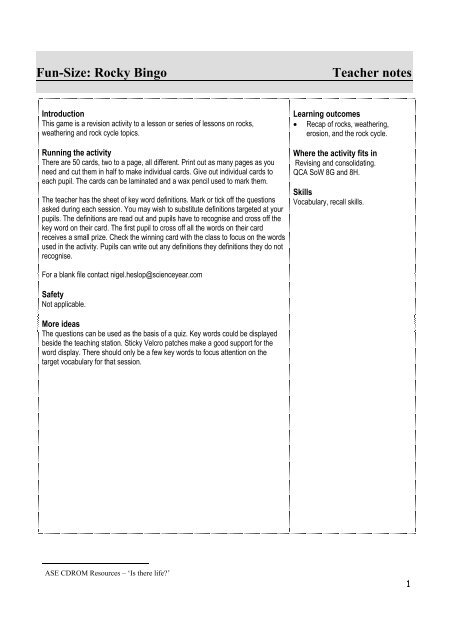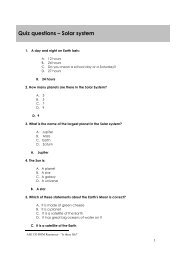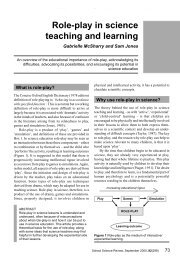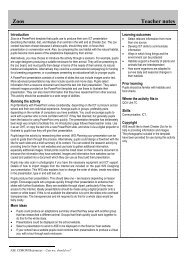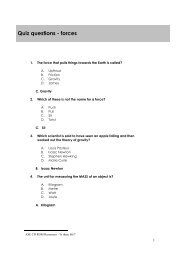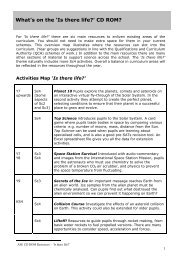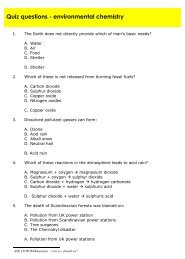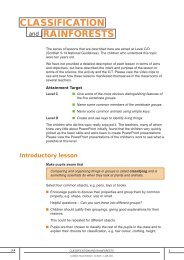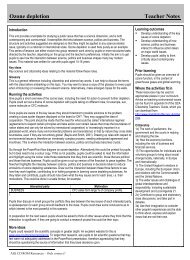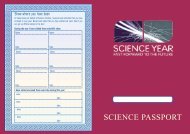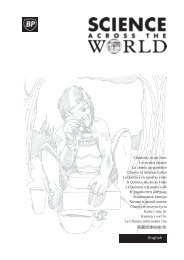Rocky Bingo Teacher notes - ASE Science Year CD Roms Online
Rocky Bingo Teacher notes - ASE Science Year CD Roms Online
Rocky Bingo Teacher notes - ASE Science Year CD Roms Online
You also want an ePaper? Increase the reach of your titles
YUMPU automatically turns print PDFs into web optimized ePapers that Google loves.
Fun-Size: <strong>Rocky</strong> <strong>Bingo</strong><br />
<strong>Teacher</strong> <strong>notes</strong><br />
Introduction<br />
This game is a revision activity to a lesson or series of lessons on rocks,<br />
weathering and rock cycle topics.<br />
Running the activity<br />
There are 50 cards, two to a page, all different. Print out as many pages as you<br />
need and cut them in half to make individual cards. Give out individual cards to<br />
each pupil. The cards can be laminated and a wax pencil used to mark them.<br />
The teacher has the sheet of key word definitions. Mark or tick off the questions<br />
asked during each session. You may wish to substitute definitions targeted at your<br />
pupils. The definitions are read out and pupils have to recognise and cross off the<br />
key word on their card. The first pupil to cross off all the words on their card<br />
receives a small prize. Check the winning card with the class to focus on the words<br />
used in the activity. Pupils can write out any definitions they definitions they do not<br />
recognise.<br />
Learning outcomes<br />
Recap of rocks, weathering,<br />
erosion, and the rock cycle.<br />
Where the activity fits in<br />
Revising and consolidating.<br />
QCA SoW 8G and 8H.<br />
Skills<br />
Vocabulary, recall skills.<br />
For a blank file contact nigel.heslop@scienceyear.com<br />
Safety<br />
Not applicable.<br />
More ideas<br />
The questions can be used as the basis of a quiz. Key words could be displayed<br />
beside the teaching station. Sticky Velcro patches make a good support for the<br />
word display. There should only be a few key words to focus attention on the<br />
target vocabulary for that session.<br />
<br />
<strong>ASE</strong> <strong>CD</strong>ROM Resources – ‘Is there life?’<br />
1
Fun-Size: <strong>Rocky</strong> <strong>Bingo</strong> <strong>Teacher</strong> <strong>notes</strong><br />
Tick these off when used in the session<br />
Rocks formed from molten material:<br />
Rocks that get changed by heating and pressure:<br />
Rocks made by the actions of moving water:<br />
When the weather breaks up and moves rock particles:<br />
Material making up the magnetic core of the Earth:<br />
Where molten rock flows out of the Earth:<br />
The molten rock that comes out of volcanoes:<br />
Molten rock under the surface of the Earth:<br />
A white hard rock that fizzes with acids:<br />
These can grow in cracks and split rocks:<br />
When molten rock cools slowly it forms ... :<br />
When molten rock is cooled very quickly it forms ... :<br />
In wet weather this can help split rocks:<br />
When water freezes it ... :<br />
A pile of stones that have been weathered from the side of a mountain:<br />
The name for the solid surface of the Earth:<br />
When gas, ash and lava comes out of a volcano:<br />
The name for the big sections of the Earth's surface that move past each other:<br />
When pollution dissolves in rain clouds this causes .... :<br />
The name for layers in rock:<br />
<br />
Igneous<br />
Metamorphic<br />
Sedimentary<br />
Erosion<br />
Iron and Nickel<br />
Volcano<br />
Lava<br />
Magma<br />
Marble<br />
Roots<br />
Large crystals<br />
Small crystals<br />
Freeze / Thaw<br />
Expands<br />
Scree<br />
Crust<br />
Eruption<br />
Tectonic plates<br />
Acid rain<br />
Strata<br />
<strong>ASE</strong> <strong>CD</strong>ROM Resources – ‘Is there life?’<br />
2
<strong>Rocky</strong> <strong>Bingo</strong> Card<br />
Igneous Metamorphic Sedimentary<br />
Volcano Magma Roots<br />
Large crystals Small crystals Expands<br />
Crust Acid rain Strata<br />
<strong>Rocky</strong> <strong>Bingo</strong> Card<br />
Igneous Metamorphic Erosion<br />
Volcano Marble Roots<br />
Large crystals Small crystals Scree<br />
Eruption Tectonic plates Acid rain<br />
3
<strong>Rocky</strong> <strong>Bingo</strong> Card<br />
Igneous Metamorphic Iron and<br />
Nickel<br />
Lava Magma Marble<br />
Large crystals Freeze / Thaw Expands<br />
Eruption Tectonic plates Strata<br />
<strong>Rocky</strong> <strong>Bingo</strong> Card<br />
Igneous Sedimentary Erosion<br />
Lava Magma Roots<br />
Large crystals Freeze / Thaw Scree<br />
Eruption Acid rain Strata<br />
4
<strong>Rocky</strong> <strong>Bingo</strong> Card<br />
Igneous Sedimentary Iron and<br />
Nickel<br />
Lava Marble Roots<br />
Large crystals Expands Scree<br />
Tectonic plates Acid rain Strata<br />
<strong>Rocky</strong> <strong>Bingo</strong> Card<br />
Igneous Erosion Iron and<br />
Nickel<br />
Magma Marble Roots<br />
Small crystals Freeze / Thaw Expands<br />
Crust Eruption Tectonic plates<br />
5
<strong>Rocky</strong> <strong>Bingo</strong> Card<br />
Metamorphic Sedimentary Erosion<br />
Volcano Lava Magma<br />
Small crystals Freeze / Thaw Scree<br />
Crust Eruption Acid rain<br />
<strong>Rocky</strong> <strong>Bingo</strong> Card<br />
Metamorphic Sedimentary Iron and<br />
Nickel<br />
Volcano Lava Marble<br />
Small crystals Expands Scree<br />
Crust Eruption Strata<br />
6
<strong>Rocky</strong> <strong>Bingo</strong> Card<br />
Metamorphic Erosion Iron and<br />
Nickel<br />
Volcano Lava Roots<br />
Freeze / Thaw Expands Scree<br />
Crust Tectonic plates Acid rain<br />
<strong>Rocky</strong> <strong>Bingo</strong> Card<br />
Sedimentary Erosion Iron and<br />
Nickel<br />
Volcano Magma Marble<br />
Large crystals Small crystals Freeze / Thaw<br />
Crust Tectonic plates Strata<br />
7
<strong>Rocky</strong> <strong>Bingo</strong> Card<br />
Igneous Sedimentary Iron and<br />
Nickel<br />
Volcano Lava Magma<br />
Large crystals Small crystals Scree<br />
Eruption Acid rain Strata<br />
<strong>Rocky</strong> <strong>Bingo</strong> Card<br />
Igneous Erosion Iron and<br />
Nickel<br />
Volcano Lava Marble<br />
Large crystals Freeze / Thaw Expands<br />
Tectonic plates Acid rain Strata<br />
8
<strong>Rocky</strong> <strong>Bingo</strong> Card<br />
Metamorphic Sedimentary Erosion<br />
Volcano Lava Roots<br />
Large crystals Freeze / Thaw Scree<br />
Crust Eruption Tectonic plates<br />
<strong>Rocky</strong> <strong>Bingo</strong> Card<br />
Metamorphic Sedimentary Iron and<br />
Nickel<br />
Volcano Magma Marble<br />
Large crystals Expands Scree<br />
Crust Eruption Acid rain<br />
9
<strong>Rocky</strong> <strong>Bingo</strong> Card<br />
Metamorphic Erosion Iron and<br />
Nickel<br />
Volcano Magma Roots<br />
Small crystals Freeze / Thaw Expands<br />
Crust Eruption Strata<br />
<strong>Rocky</strong> <strong>Bingo</strong> Card<br />
Sedimentary Erosion Iron and<br />
Nickel<br />
Volcano Marble Roots<br />
Small crystals Freeze / Thaw Scree<br />
Crust Tectonic plates Acid rain<br />
10
<strong>Rocky</strong> <strong>Bingo</strong> Card<br />
Igneous Metamorphic Sedimentary<br />
Lava Magma Marble<br />
Small crystals Expands Scree<br />
Crust<br />
Tectonic<br />
plates<br />
Strata<br />
<strong>Rocky</strong> <strong>Bingo</strong> Card<br />
Igneous Metamorphic Erosion<br />
Lava Magma Roots<br />
Freeze / Thaw Expands Scree<br />
Crust Acid rain Strata<br />
11
<strong>Rocky</strong> <strong>Bingo</strong> Card<br />
Igneous Metamorphic Iron and<br />
Nickel<br />
Lava Marble Roots<br />
Large crystals Small crystals Freeze / Thaw<br />
Eruption Tectonic plates Acid rain<br />
<strong>Rocky</strong> <strong>Bingo</strong> Card<br />
Igneous Sedimentary Erosion<br />
Magma Marble Roots<br />
Large crystals Small crystals Expands<br />
Eruption Tectonic plates Strata<br />
12
<strong>Rocky</strong> <strong>Bingo</strong> Card<br />
Metamorphic Erosion Iron and<br />
Nickel<br />
Volcano Lava Magma<br />
Large crystals Freeze / Thaw Expands<br />
Crust Acid rain Strata<br />
<strong>Rocky</strong> <strong>Bingo</strong> Card<br />
Sedimentary Erosion Iron and<br />
Nickel<br />
Volcano Lava Marble<br />
Large crystals Freeze / Thaw Scree<br />
Eruption<br />
Tectonic<br />
plates<br />
Acid rain<br />
13
<strong>Rocky</strong> <strong>Bingo</strong> Card<br />
Igneous Metamorphic Sedimentary<br />
Volcano Lava Roots<br />
Large crystals Expands Scree<br />
Eruption Tectonic plates Strata<br />
<strong>Rocky</strong> <strong>Bingo</strong> Card<br />
Igneous Metamorphic Erosion<br />
Volcano Magma Marble<br />
Small crystals Freeze / Thaw Expands<br />
Eruption Acid rain Strata<br />
14
<strong>Rocky</strong> <strong>Bingo</strong> Card<br />
Igneous Metamorphic Iron and<br />
Nickel<br />
Volcano Magma Roots<br />
Small crystals Freeze / Thaw Scree<br />
Tectonic<br />
plates<br />
Acid rain<br />
Strata<br />
<strong>Rocky</strong> <strong>Bingo</strong> Card<br />
Igneous Sedimentary Erosion<br />
Volcano Marble Roots<br />
Small crystals Expands Scree<br />
Crust Eruption Tectonic<br />
plates<br />
15
<strong>Rocky</strong> <strong>Bingo</strong> Card<br />
Igneous Sedimentary Iron and<br />
Nickel<br />
Lava Magma Marble<br />
Freeze / Thaw Expands Scree<br />
Crust Eruption Acid rain<br />
<strong>Rocky</strong> <strong>Bingo</strong> Card<br />
Igneous Erosion Iron and<br />
Nickel<br />
Lava Magma Roots<br />
Large crystals Small crystals Freeze / Thaw<br />
Crust Eruption Strata<br />
16
<strong>Rocky</strong> <strong>Bingo</strong> Card<br />
Metamorphic Sedimentary Erosion<br />
Lava Marble Roots<br />
Large crystals Small crystals Expands<br />
Crust<br />
Tectonic<br />
plates<br />
Acid rain<br />
<strong>Rocky</strong> <strong>Bingo</strong> Card<br />
Metamorphic Sedimentary Iron and<br />
Nickel<br />
Magma Marble Roots<br />
Large crystals Small crystals Scree<br />
Crust<br />
Tectonic<br />
plates<br />
Strata<br />
17
<strong>Rocky</strong> <strong>Bingo</strong> Card<br />
Igneous Metamorphic Sedimentary<br />
Lava Marble Roots<br />
Large crystals Freeze / Thaw Scree<br />
Eruption Tectonic plates Acid rain<br />
<strong>Rocky</strong> <strong>Bingo</strong> Card<br />
Igneous Metamorphic Erosion<br />
Magma Marble Roots<br />
Large crystals Expands Scree<br />
Eruption Tectonic plates Strata<br />
18
<strong>Rocky</strong> <strong>Bingo</strong> Card<br />
Igneous Metamorphic Iron and<br />
Nickel<br />
Volcano Lava Magma<br />
Small crystals Freeze / Thaw Expands<br />
Eruption Acid rain Strata<br />
<strong>Rocky</strong> <strong>Bingo</strong> Card<br />
Igneous Sedimentary Erosion<br />
Volcano Lava Marble<br />
Small crystals Freeze / Thaw Scree<br />
Tectonic<br />
plates<br />
Acid rain<br />
Strata<br />
19
<strong>Rocky</strong> <strong>Bingo</strong> Card<br />
Igneous Sedimentary Iron and<br />
Nickel<br />
Volcano Lava Roots<br />
Small crystals Expands Scree<br />
Crust Eruption Tectonic plates<br />
<strong>Rocky</strong> <strong>Bingo</strong> Card<br />
Igneous Erosion Iron and<br />
Nickel<br />
Volcano Magma Marble<br />
Freeze / Thaw Expands Scree<br />
Crust Eruption Acid rain<br />
20
<strong>Rocky</strong> <strong>Bingo</strong> Card<br />
Metamorphic Sedimentary Erosion<br />
Volcano Magma Roots<br />
Large crystals Small crystals Freeze / Thaw<br />
Crust Eruption Strata<br />
<strong>Rocky</strong> <strong>Bingo</strong> Card<br />
Metamorphic Sedimentary Iron and<br />
Nickel<br />
Volcano Marble Roots<br />
Large crystals Small crystals Expands<br />
Crust<br />
Tectonic<br />
plates<br />
Acid rain<br />
21
<strong>Rocky</strong> <strong>Bingo</strong> Card<br />
Metamorphic Erosion Iron and<br />
Nickel<br />
Lava Magma Marble<br />
Large crystals Small crystals Scree<br />
Crust Tectonic plates Strata<br />
<strong>Rocky</strong> <strong>Bingo</strong> Card<br />
Sedimentary Erosion Iron and<br />
Nickel<br />
Lava Magma Roots<br />
Large crystals Freeze / Thaw Expands<br />
Crust Acid rain Strata<br />
22
<strong>Rocky</strong> <strong>Bingo</strong> Card<br />
Igneous Metamorphic Sedimentary<br />
Volcano Magma Marble<br />
Small crystals Freeze / Thaw Scree<br />
Crust Eruption Acid rain<br />
<strong>Rocky</strong> <strong>Bingo</strong> Card<br />
Igneous Metamorphic Erosion<br />
Volcano Magma Roots<br />
Small crystals Expands Scree<br />
Crust Eruption Strata<br />
23
<strong>Rocky</strong> <strong>Bingo</strong> Card<br />
Igneous Metamorphic Iron and<br />
Nickel<br />
Volcano Marble Roots<br />
Freeze / Thaw Expands Scree<br />
Crust Tectonic plates Acid rain<br />
<strong>Rocky</strong> <strong>Bingo</strong> Card<br />
Igneous Sedimentary Erosion<br />
Lava Magma Marble<br />
Large crystals Small crystals Freeze / Thaw<br />
Crust Tectonic plates Strata<br />
24
<strong>Rocky</strong> <strong>Bingo</strong> Card<br />
Igneous Sedimentary Iron and<br />
Nickel<br />
Lava Magma Roots<br />
Large crystals Small crystals Expands<br />
Crust Acid rain Strata<br />
<strong>Rocky</strong> <strong>Bingo</strong> Card<br />
Igneous Erosion Iron and<br />
Nickel<br />
Lava Marble Roots<br />
Large crystals Small crystals Scree<br />
Eruption Tectonic plates Acid rain<br />
25
<strong>Rocky</strong> <strong>Bingo</strong> Card<br />
Metamorphic Sedimentary Erosion<br />
Magma Marble Roots<br />
Large crystals Freeze / Thaw Expands<br />
Eruption Tectonic plates Strata<br />
<strong>Rocky</strong> <strong>Bingo</strong> Card<br />
Metamorphic Sedimentary Iron and<br />
Nickel<br />
Volcano Lava Magma<br />
Large crystals Freeze / Thaw Scree<br />
Eruption Acid rain Strata<br />
26
<strong>Rocky</strong> <strong>Bingo</strong> Card<br />
Metamorphic Erosion Iron and<br />
Nickel<br />
Volcano Lava Marble<br />
Large crystals Expands Scree<br />
Tectonic plates Acid rain Strata<br />
<strong>Rocky</strong> <strong>Bingo</strong> Card<br />
Sedimentary Erosion Iron and<br />
Nickel<br />
Volcano Lava Roots<br />
Small crystals Freeze / Thaw Expands<br />
Crust Eruption Tectonic plates<br />
27
Fun-Size: Periodic Table <strong>Bingo</strong><br />
<strong>Teacher</strong> <strong>notes</strong><br />
Introduction<br />
This game is a revision activity to a lesson or series of lessons on periodic table<br />
topics.<br />
Running the activity<br />
There are 50 cards, two to a page, all different. Print out as many pages as you<br />
need and cut them in half to make individual cards. Give out individual cards to<br />
each pupil. The cards can be laminated and a wax pencil used to mark them.<br />
The teacher has the sheet of key word definitions. Mark or tick off the questions<br />
asked during each session. You may wish to substitute definitions targeted at your<br />
pupils. The definitions are read out and pupils have to recognise and cross off the<br />
key word on their card. The first pupil to cross off all the words on their card<br />
receives a small prize. Check the winning card with the class to focus on the words<br />
used in the activity. Pupils can write out any definitions they definitions they do not<br />
recognise.<br />
Learning outcomes<br />
Recap periodic table and<br />
properties of elements.<br />
Where the activity fits in<br />
Revising and consolidating.<br />
QCA SoW 8E and 8F.<br />
Skills<br />
Vocabulary, recall skills.<br />
Acknowledgements<br />
Thank you to Lorna Coulson of Langley<br />
Park School for this activity.<br />
For a blank file contact nigel.heslop@scienceyear.com<br />
Safety<br />
Not applicable.<br />
More ideas<br />
The questions can be used as the basis of a quiz. Key words could be displayed<br />
beside the teaching station. Sticky Velcro patches make a good support for the<br />
word display. There should only be a few key words to focus attention on the<br />
target vocabulary for that session.<br />
<br />
<strong>ASE</strong> <strong>CD</strong>ROM Resources – ‘Is there life?’<br />
1
Fun-Size: Periodic Table <strong>Bingo</strong><br />
<strong>Teacher</strong> <strong>notes</strong><br />
Tick these off when used in the session<br />
This metal can be used to make drink cans and saucepans:<br />
A compound of this metal is essential for strong teeth:<br />
A halogen, used as an antiseptic and as a test for starch:<br />
A gas that gives a ‘squeaky pop’ with a lighted splint:<br />
Metal that reacts with water, burning with a lilac flame:<br />
Metal used in fireworks. Burns with a bright, white flame:<br />
Name of the vertical columns in the Periodic Table:<br />
Another name for a policeman:<br />
A solid yellow non-metal. Burns to make an acidic gas:<br />
A green gas, used in swimming pools to kill germs:<br />
This halogen is the most reactive non-metal.<br />
Compounds of this element are added to toothpaste:<br />
Sliver metal that is liquid at room temperature:<br />
Name for a horizontal line in the Periodic Table:<br />
Which of these is not a metal: gold, aluminium, carbon or copper?:<br />
The gas in air we use for respiration:<br />
Word used to describe the metals in Group 1:<br />
Non-flammable gas used to fill balloons:<br />
When wet, this element reacts slowly with oxygen to form rust.<br />
Shortages of this element in the diet can cause anaemia:<br />
This gas makes up four fifths of air:<br />
On which side of the Periodic Table are the metals found?<br />
<br />
Aluminium<br />
Calcium<br />
Iodine<br />
Hydrogen<br />
Potassium<br />
Magnesium<br />
Groups<br />
Copper<br />
Sulphur<br />
Chlorine<br />
Fluorine<br />
Mercury<br />
Period<br />
Carbon<br />
Oxygen<br />
Alkali<br />
Helium<br />
Iron<br />
Nitrogen<br />
Left<br />
<strong>ASE</strong> <strong>CD</strong>ROM Resources – ‘Is there life?’<br />
2
Periodic Table <strong>Bingo</strong> Card<br />
Aluminium Calcium Iodine<br />
Magnesium Copper Chlorine<br />
Fluorine Mercury Carbon<br />
Alkali Nitrogen Left<br />
Periodic Table <strong>Bingo</strong> Card<br />
Aluminium Calcium Hydrogen<br />
Magnesium Sulphur Chlorine<br />
Fluorine Mercury Oxygen<br />
Helium Iron Nitrogen<br />
3
Periodic Table <strong>Bingo</strong> Card<br />
Aluminium Calcium Potassium<br />
Groups Copper Sulphur<br />
Fluorine Period Carbon<br />
Helium Iron Left<br />
Periodic Table <strong>Bingo</strong> Card<br />
Aluminium Iodine Hydrogen<br />
Groups Copper Chlorine<br />
Fluorine Period Oxygen<br />
Helium Nitrogen Left<br />
4
Periodic Table <strong>Bingo</strong> Card<br />
Aluminium Iodine Potassium<br />
Groups Sulphur Chlorine<br />
Fluorine Carbon Oxygen<br />
Iron Nitrogen Left<br />
Periodic Table <strong>Bingo</strong> Card<br />
Aluminium Hydrogen Potassium<br />
Copper Sulphur Chlorine<br />
Mercury Period Carbon<br />
Alkali Helium Iron<br />
5
Periodic Table <strong>Bingo</strong> Card<br />
Calcium Iodine Hydrogen<br />
Magnesium Groups Copper<br />
Mercury Period Oxygen<br />
Alkali Helium Nitrogen<br />
Periodic Table <strong>Bingo</strong> Card<br />
Calcium Iodine Potassium<br />
Magnesium Groups Sulphur<br />
Mercury Carbon Oxygen<br />
Alkali Helium Left<br />
6
Periodic Table <strong>Bingo</strong> Card<br />
Calcium Hydrogen Potassium<br />
Magnesium Groups Chlorine<br />
Period Carbon Oxygen<br />
Alkali Iron Nitrogen<br />
Periodic Table <strong>Bingo</strong> Card<br />
Iodine Hydrogen Potassium<br />
Magnesium Copper Sulphur<br />
Fluorine Mercury Period<br />
Alkali Iron Left<br />
7
Periodic Table <strong>Bingo</strong> Card<br />
Aluminium Iodine Potassium<br />
Magnesium Groups Copper<br />
Fluorine Mercury Oxygen<br />
Helium Nitrogen Left<br />
Periodic Table <strong>Bingo</strong> Card<br />
Aluminium Hydrogen Potassium<br />
Magnesium Groups Sulphur<br />
Fluorine Period Carbon<br />
Iron Nitrogen Left<br />
8
Periodic Table <strong>Bingo</strong> Card<br />
Calcium Iodine Hydrogen<br />
Magnesium Groups Chlorine<br />
Fluorine Period Oxygen<br />
Alkali Helium Iron<br />
Periodic Table <strong>Bingo</strong> Card<br />
Calcium Iodine Potassium<br />
Magnesium Copper Sulphur<br />
Fluorine Carbon Oxygen<br />
Alkali Helium Nitrogen<br />
9
Periodic Table <strong>Bingo</strong> Card<br />
Calcium Hydrogen Potassium<br />
Magnesium Copper Chlorine<br />
Mercury Period Carbon<br />
Alkali Helium Left<br />
Periodic Table <strong>Bingo</strong> Card<br />
Iodine Hydrogen Potassium<br />
Magnesium Sulphur Chlorine<br />
Mercury Period Oxygen<br />
Alkali Iron Nitrogen<br />
10
Periodic Table <strong>Bingo</strong> Card<br />
Aluminium Calcium Iodine<br />
Groups Copper Sulphur<br />
Mercury Carbon Oxygen<br />
Alkali Iron Left<br />
Periodic Table <strong>Bingo</strong> Card<br />
Aluminium Calcium Hydrogen<br />
Groups Copper Chlorine<br />
Period Carbon Oxygen<br />
Alkali Nitrogen Left<br />
11
Periodic Table <strong>Bingo</strong> Card<br />
Aluminium Calcium Potassium<br />
Groups Sulphur Chlorine<br />
Fluorine Mercury Period<br />
Helium Iron Nitrogen<br />
Periodic Table <strong>Bingo</strong> Card<br />
Aluminium Iodine Hydrogen<br />
Copper Sulphur Chlorine<br />
Fluorine Mercury Carbon<br />
Helium Iron Left<br />
12
Periodic Table <strong>Bingo</strong> Card<br />
Calcium Hydrogen Potassium<br />
Magnesium Groups Copper<br />
Fluorine Period Carbon<br />
Alkali Nitrogen Left<br />
Periodic Table <strong>Bingo</strong> Card<br />
Iodine Hydrogen Potassium<br />
Magnesium Groups Sulphur<br />
Fluorine Period Oxygen<br />
Helium Iron Nitrogen<br />
13
Periodic Table <strong>Bingo</strong> Card<br />
Aluminium Calcium Iodine<br />
Magnesium Groups Chlorine<br />
Fluorine Carbon Oxygen<br />
Helium Iron Left<br />
Periodic Table <strong>Bingo</strong> Card<br />
Aluminium Calcium Hydrogen<br />
Magnesium Copper Sulphur<br />
Mercury Period Carbon<br />
Helium Nitrogen Left<br />
14
Periodic Table <strong>Bingo</strong> Card<br />
Aluminium Calcium Potassium<br />
Magnesium Copper Chlorine<br />
Mercury Period Oxygen<br />
Iron Nitrogen Left<br />
Periodic Table <strong>Bingo</strong> Card<br />
Aluminium Iodine Hydrogen<br />
Magnesium Sulphur Chlorine<br />
Mercury Carbon Oxygen<br />
Alkali Helium Iron<br />
15
Periodic Table <strong>Bingo</strong> Card<br />
Aluminium Iodine Potassium<br />
Groups Copper Sulphur<br />
Period Carbon Oxygen<br />
Alkali Helium Nitrogen<br />
Periodic Table <strong>Bingo</strong> Card<br />
Aluminium Hydrogen Potassium<br />
Groups Copper Chlorine<br />
Fluorine Mercury Period<br />
Alkali Helium Left<br />
16
Periodic Table <strong>Bingo</strong> Card<br />
Calcium Iodine Hydrogen<br />
Groups Sulphur Chlorine<br />
Fluorine Mercury Carbon<br />
Alkali Iron Nitrogen<br />
Periodic Table <strong>Bingo</strong> Card<br />
Calcium Iodine Potassium<br />
Copper Sulphur Chlorine<br />
Fluorine Mercury Oxygen<br />
Alkali Iron Left<br />
17
Periodic Table <strong>Bingo</strong> Card<br />
Aluminium Calcium Iodine<br />
Groups Sulphur Chlorine<br />
Fluorine Period Oxygen<br />
Helium Iron Nitrogen<br />
Periodic Table <strong>Bingo</strong> Card<br />
Aluminium Calcium Hydrogen<br />
Copper Sulphur Chlorine<br />
Fluorine Carbon Oxygen<br />
Helium Iron Left<br />
18
Periodic Table <strong>Bingo</strong> Card<br />
Aluminium Calcium Potassium<br />
Magnesium Groups Copper<br />
Mercury Period Carbon<br />
Helium Nitrogen Left<br />
Periodic Table <strong>Bingo</strong> Card<br />
Aluminium Iodine Hydrogen<br />
Magnesium Groups Sulphur<br />
Mercury Period Oxygen<br />
Iron Nitrogen Left<br />
19
Periodic Table <strong>Bingo</strong> Card<br />
Aluminium Iodine Potassium<br />
Magnesium Groups Chlorine<br />
Mercury Carbon Oxygen<br />
Alkali Helium Iron<br />
Periodic Table <strong>Bingo</strong> Card<br />
Aluminium Hydrogen Potassium<br />
Magnesium Copper Sulphur<br />
Period Carbon Oxygen<br />
Alkali Helium Nitrogen<br />
20
Periodic Table <strong>Bingo</strong> Card<br />
Calcium Iodine Hydrogen<br />
Magnesium Copper Chlorine<br />
Fluorine Mercury Period<br />
Alkali Helium Left<br />
Periodic Table <strong>Bingo</strong> Card<br />
Calcium Iodine Potassium<br />
Magnesium Sulphur Chlorine<br />
Fluorine Mercury Carbon<br />
Alkali Iron Nitrogen<br />
21
Periodic Table <strong>Bingo</strong> Card<br />
Calcium Hydrogen Potassium<br />
Groups Copper Sulphur<br />
Fluorine Mercury Oxygen<br />
Alkali Iron Left<br />
Periodic Table <strong>Bingo</strong> Card<br />
Iodine Hydrogen Potassium<br />
Groups Copper Chlorine<br />
Fluorine Period Carbon<br />
Alkali Nitrogen Left<br />
22
Periodic Table <strong>Bingo</strong> Card<br />
Aluminium Calcium Iodine<br />
Magnesium Copper Sulphur<br />
Mercury Period Oxygen<br />
Alkali Helium Nitrogen<br />
Periodic Table <strong>Bingo</strong> Card<br />
Aluminium Calcium Hydrogen<br />
Magnesium Copper Chlorine<br />
Mercury Carbon Oxygen<br />
Alkali Helium Left<br />
23
Periodic Table <strong>Bingo</strong> Card<br />
Aluminium Calcium Potassium<br />
Magnesium Sulphur Chlorine<br />
Period Carbon Oxygen<br />
Alkali Iron Nitrogen<br />
Periodic Table <strong>Bingo</strong> Card<br />
Aluminium Iodine Hydrogen<br />
Groups Copper Sulphur<br />
Fluorine Mercury Period<br />
Alkali Iron Left<br />
24
Periodic Table <strong>Bingo</strong> Card<br />
Aluminium Iodine Potassium<br />
Groups Copper Chlorine<br />
Fluorine Mercury Carbon<br />
Alkali Nitrogen Left<br />
Periodic Table <strong>Bingo</strong> Card<br />
Aluminium Hydrogen Potassium<br />
Groups Sulphur Chlorine<br />
Fluorine Mercury Oxygen<br />
Helium Iron Nitrogen<br />
25
Periodic Table <strong>Bingo</strong> Card<br />
Calcium Iodine Hydrogen<br />
Copper Sulphur Chlorine<br />
Fluorine Period Carbon<br />
Helium Iron Left<br />
Periodic Table <strong>Bingo</strong> Card<br />
Calcium Iodine Potassium<br />
Magnesium Groups Copper<br />
Fluorine Period Oxygen<br />
Helium Nitrogen Left<br />
26
Periodic Table <strong>Bingo</strong> Card<br />
Calcium Hydrogen Potassium<br />
Magnesium Groups Sulphur<br />
Fluorine Carbon Oxygen<br />
Iron Nitrogen Left<br />
Periodic Table <strong>Bingo</strong> Card<br />
Iodine Hydrogen Potassium<br />
Magnesium Groups Chlorine<br />
Mercury Period Carbon<br />
Alkali Helium Iron<br />
27
Fun-Size: Gravity & Space Traffic Lights<br />
<strong>Teacher</strong> <strong>notes</strong><br />
Introduction<br />
Learning outcomes<br />
This game is a revision activity to a lesson or series of lessons on gravity and space.<br />
<br />
Recap gravity and space.<br />
Running the activity<br />
Give each pupil three small pieces of coloured card about 10 cm square (one red, one<br />
yellow or orange, one green). These are used to signal their answers.<br />
Red means FALSE.<br />
Green means TRUE.<br />
Yellow or orange means I’M NOT SURE.<br />
Where the activity fits in<br />
Revising and consolidating<br />
QCA SoW 9J<br />
Skills<br />
Recall.<br />
The game follows this sequence:<br />
<br />
<br />
<br />
<br />
Read the question.<br />
Allow a short period of time for pupils to consider their answer.<br />
Count “1,2,3 Show your cards!”<br />
Pupils all hold up one of their card at the same time.<br />
Safety<br />
Not applicable.<br />
More ideas<br />
Use the red, yellow and orange cards to denote solid, liquid and gas. Ask straightforward<br />
questions such as ‘What state is water?’, and more stretching questions like ‘What state is<br />
toothpaste?’ (solid & liquid), ‘What state is sponge cake?’ (solid & gas). Pupils hold up two<br />
cards when appropriate.<br />
<br />
<strong>ASE</strong> <strong>CD</strong> ROM Resources – ‘Is there life?’
Fun-Size: Gravity & Space Traffic Lights<br />
Questions<br />
1. Gravity only happens on Earth.<br />
False. There is a gravity force between all objects.<br />
2. Gravity attracts things towards the surface of the Earth.<br />
False. Gravity attracts towards the centre of the Earth.<br />
3. Far away from Earth objects have no weight.<br />
True. Weight is a downward force due to gravity.<br />
4. Weight is measured in kilograms.<br />
False. Weight is a force. Forces are measured in newtons.<br />
5. Far away from Earth objects have no mass.<br />
False. Mass is a measure of how much of an object there is.<br />
6. Mass is measured in kilograms.<br />
True.<br />
7. When the Space Shuttle is orbiting the Earth the occupants mass is zero.<br />
False.<br />
8. Gravity decreases when objects are farther apart.<br />
True.<br />
9. People used to think the Sun moved round the Earth.<br />
True.<br />
10. Orbiting the Sun causes day and night.<br />
False. Day and night are caused by the Earth spinning on its axis.<br />
11. There are four inner planets and five outer planets in the Solar System.<br />
True.<br />
12. There are four gas giant planets in the Solar System.<br />
True.<br />
13. Gravity keeps the planets orbiting the Sun.<br />
True.<br />
14. Slower moving planets orbit further from the Sun.<br />
False.<br />
<br />
<strong>ASE</strong> <strong>CD</strong> ROM Resources – ‘Is there life?’
Fun-Size: Gravity & Space Traffic Lights<br />
Questions<br />
15. The Moon is a lump of matter that was broken off the Earth.<br />
Not sure. The origin of the Moon is not yet understood.<br />
16. People from Earth have only visited the Moon.<br />
True. Robot probes have visited Mars and Venus and flown past other planets.<br />
17. TV satellites are travelling rapidly through space.<br />
True. They orbit the Earth once every 24 hours, and are therefore geostationary.<br />
18. TV satellites are used for spying.<br />
False. There are many satellites at different distances from the Earth. The spy satellites<br />
are in a much lower orbit than TV satellites.<br />
19. Weather satellites stay in the same orbit.<br />
True. All satellites stay in the same orbit once they are up there. The Earth spins round<br />
under the weather satellites and they photograph the weather patterns.<br />
20. Our Universe came into existence with an event called the Big Bang.<br />
Not sure. The Big Bang is the best theory so far, but there are many others. <br />
<strong>ASE</strong> <strong>CD</strong> ROM Resources – ‘Is there life?’
Fun Size: A-Z quiz<br />
<strong>Teacher</strong> <strong>notes</strong><br />
Introduction<br />
A-Z quizzes are useful to change the pace or direction of lessons. They can be<br />
constructed for different topic areas. This example covers general knowledge and<br />
KS3 physics.<br />
Running the activity<br />
Photocopy the question sheet or use as a quiz.<br />
Do the activity against the clock to find the highest score. The questions are<br />
reasonably demanding.<br />
Safety<br />
Not applicable.<br />
More ideas<br />
Pupils can generate their own quizzes at the end of a topic.<br />
Use the quiz as a tutor time activity.<br />
Lesson outcomes<br />
Vocabulary checking<br />
Where the activity fits in<br />
As a change of pace and direction to<br />
any of the KS3 topics.<br />
As a lesson starter or finisher.<br />
As a homework.<br />
Skills<br />
Knowledge and understanding, recall,<br />
vocabulary.<br />
Acknowledgements<br />
Please send your fun size quizzes to<br />
nigel.heslop@scienceyear.com for<br />
inclusion on future <strong>CD</strong>-ROMs.<br />
<strong>ASE</strong> <strong>CD</strong>ROM Resources – ‘Is there life?’
A to Z Quiz<br />
A__________<br />
B__________<br />
C__________<br />
D__________<br />
E__________<br />
F__________<br />
G__________<br />
H__________<br />
I___________<br />
J__________<br />
K__________<br />
L__________<br />
M_________<br />
N__________<br />
O__________<br />
P__________<br />
Q__________<br />
R__________<br />
S__________<br />
T__________<br />
U__________<br />
V__________<br />
W__________<br />
X__________<br />
Y__________<br />
Z__________<br />
<br />
First man to walk on the Moon.<br />
The Universe started with a big one of these.<br />
This has a tail when it is near to the Sun.<br />
The surface of the Moon is covered with this.<br />
A moon of Jupiter where there is ice. There could be life there.<br />
The Earth’s gravity _______. Pulls us downwards.<br />
One of the first people to say that the Earth orbited the Sun.<br />
The fuel used to keep the sun shining.<br />
Water in space turns into this.<br />
The largest gas giant planet.<br />
Movement energy.<br />
To do with the Moon.<br />
A rock from outer space.<br />
Number of planets in the Solar System.<br />
Means going round (planets do this round the Sun).<br />
Outermost planet. Is it a planet?<br />
We use this type of crystal in very accurate clocks.<br />
Found round Saturn.<br />
An object that orbits another.<br />
Sends out radio signals.<br />
An outer planet.<br />
An inner planet.<br />
Force from gravity.<br />
Another name for a photocopy (light!).<br />
One orbit of the Sun in time.<br />
When the Sun is at its highest point in the sky.<br />
<strong>ASE</strong> <strong>CD</strong> ROM Resources – ‘Is there life?’
A to Z Quiz<br />
Armstrong<br />
First man to walk on the Moon.<br />
Bang<br />
The Universe started with a big one of these.<br />
Comet<br />
This has a tail when it is near to the Sun.<br />
Dust<br />
The surface of the Moon is covered with this<br />
Europa<br />
A moon of Jupiter where there is ice.<br />
There could be life there.<br />
Field The Earth’s gravity _____. Pulls us downwards .<br />
Galileo<br />
One of the first people to say that the Earth orbits the Sun.<br />
Hydrogen<br />
The fuel used to keep the Sun shining<br />
Ice<br />
Water in space turns into this.<br />
Jupiter<br />
The largest gas giant planet.<br />
Kinetic<br />
Movement energy.<br />
Lunar<br />
To do with the Moon.<br />
Meteor<br />
A rock from outer space.<br />
Nine<br />
Number of planets in the Solar System.<br />
Orbit<br />
Means going round (planets do this around the Sun).<br />
Pluto<br />
Outermost planet. Is it a planet?<br />
Quartz<br />
We use this type of crystal in very accurate clocks.<br />
Ring<br />
Found round Saturn.<br />
Satellite<br />
An object that orbits another.<br />
Transmitter<br />
Sends out radio signals.<br />
Uranus<br />
An outer planet.<br />
Venus<br />
An inner planet.<br />
Weight<br />
Force from gravity.<br />
Xerox<br />
Another name for a photocopy (light!).<br />
<strong>Year</strong><br />
One orbit of the Sun in time.<br />
Zenith<br />
When the Sun is at its highest point in the sky.<br />
<br />
<strong>ASE</strong> <strong>CD</strong> ROM Resources – ‘Is there life?’
Fun Size: Speed Pelmanism<br />
<strong>Teacher</strong> <strong>notes</strong><br />
Introduction<br />
Pelmanism is a term for the children’s game of ‘Pairs’. In this version pupils do not<br />
have to recognise identical pairs, but they must put together the start and end of a<br />
statement or question. The starts are printed in blue and the ends in black to avoid<br />
confusion.<br />
Running the activity<br />
Print off the card sheets and cut into individual cards. Laminate if you wish for<br />
durability. There are 52 cards in a pack. One pack is required for each group of<br />
four.<br />
Pupils shuffle and spread the cards out face down. They each take it in turn to turn<br />
over two cards at a time. If the second completes the first card, they keep that pair<br />
and try again. If the second card does not complete the first, they turn them face<br />
down again and the next pupil begins their go. The winner is the pupil with the<br />
most pairs when all have been claimed.<br />
Two, three or four pupils may play the game. To turn this into a question loop<br />
game laminate together the question card with the next answer in the set (Q1 goes<br />
with A2 etc.).<br />
Lesson outcomes<br />
Calculation of speed, factors<br />
affecting friction, balanced forces,<br />
air resistance.<br />
Where the activity fits in<br />
Speed and velocity calculation topics<br />
QCA SoW Unit 9K.<br />
Skills<br />
Vocabulary, numeracy.<br />
Acknowledgements<br />
Please send your fun size quizzes to<br />
nigel.heslop@scienceyear.com for<br />
inclusion on future <strong>CD</strong>-ROMs.<br />
N.B. Pupils may need calculators.<br />
Safety<br />
Not applicable<br />
More ideas<br />
Pupils can generate their own questions to add to the set.<br />
<strong>ASE</strong> <strong>CD</strong>ROM Resources – ‘Is there life?’
1. A mouse runs 24 metres in 6 seconds.<br />
What speed is the mouse running at?<br />
A 4 metres per second<br />
Q2 A greyhound runs 400 metres in 16<br />
seconds. What speed is it running at?<br />
A 25 metres per second
Q3 How fast does a snail travel if it<br />
moves 1 metre in 5 seconds?<br />
A 0.2 metres per second<br />
Q4 A human runs 200 metres in 20<br />
seconds. Calculate their speed.<br />
A. 10 metres per second
Q5 A cat runs 60 metres in 3 seconds.<br />
What is its speed?<br />
A 20 metres per second<br />
Q6 In air, sound travels 66 metres in<br />
0.2 seconds. What is the speed of<br />
sound?<br />
A 330 metres per second
Q7 A tortoise can walk 10 metres in 50<br />
seconds. Calculate its speed.<br />
A 0.2 metres per second<br />
Q8 A bullet moves 400 metres in 2<br />
seconds. What speed is it moving at?<br />
A 200 metres per second
Q9 A human runs 400 metres in 50<br />
seconds. What is their speed?<br />
A 8 metres per second<br />
Q10 A human runs 12,000 metres<br />
(12km) in 40 minutes (2,400 seconds).<br />
What is their speed?<br />
A 5 metres per second
Q11 A chimp climbs a 30 metre tree in<br />
10 seconds. What is the climbing speed?<br />
A 3 metres per second<br />
Q12 A car travels 144 kilometres in 1<br />
hour. What is the car’s speed in metres<br />
per second?<br />
A 40 metres per second
Q13 How do you calculate “distance<br />
travelled”?<br />
A speed x time<br />
Q14 What is the meaning of<br />
acceleration?<br />
A The speed of an object is changing.
Q15 What is the accuracy of athletics<br />
lap timing?<br />
A The nearest one hundredth of a<br />
second.<br />
Q16 What is the accuracy of motor<br />
racing timing?<br />
A The nearest one thousandth of a<br />
second, because the speeds are so much<br />
faster.
Q17 What produces acceleration?<br />
A An unbalanced force.<br />
Q18 Why has a submarine got a smooth<br />
shape?<br />
A To reduce friction or drag from the<br />
water.
Q19 Why has a parachute got that<br />
mushroom shape?<br />
A To produce a lot of air resistance.<br />
Q20 What effect does high air<br />
resistance have on falling objects?<br />
A It reduces the speed at which they<br />
fall to Earth.
Q21 What do car designers do to make<br />
car body shapes better?<br />
A They streamline the shape.<br />
Q22 Why do you slip over easily on ice?<br />
A Ice has low friction.
Q23 What makes you move forward<br />
when you run?<br />
A Your feet pushing against the ground.<br />
To do this you need high friction.<br />
Q24 What units do we use for distance<br />
travelled?<br />
A Metres and kilometres
Q 25 What is the formula for<br />
calculating speed?<br />
A<br />
Speed = distance travelled<br />
time<br />
Q 26 What do we call the sensors used<br />
in computer data logging of distance<br />
travelled and time taken?<br />
A Light gates
Q 27 What do we call the sensor used in<br />
a police speed trap?<br />
A. A radar speed detector.


